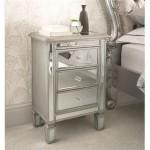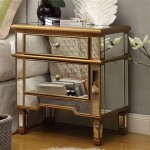Antique Vanity With Round Mirror Value: A Comprehensive Guide
The allure of antique vanities, particularly those adorned with round mirrors, stems from their intrinsic beauty, historical significance, and inherent value. Understanding the factors that influence the worth of these pieces requires a nuanced approach, considering aspects from craftsmanship and provenance to market trends and condition. This article provides a comprehensive guide to assessing the value of antique vanities with round mirrors.
Factors Determining Antique Vanity Value
Several key factors contribute to the overall value of an antique vanity with a round mirror. These factors are often interdependent and require careful evaluation to arrive at a reasonable estimate of worth.
Age and Rarity: The age of an antique vanity is a primary determinant of its value. Generally, older vanities, particularly those from the 18th and 19th centuries, command higher prices. Vanities considered rare due to their unique design, limited production numbers, or association with a prominent maker are also highly sought after. Determining the age requires careful examination of construction techniques, materials used, and stylistic features.
Material and Craftsmanship: The materials employed in the construction of the vanity significantly impact its value. Solid wood construction, particularly using high-quality timbers like mahogany, walnut, or rosewood, is preferable to veneer over less expensive woods. The quality of craftsmanship is equally important. Look for dovetail joints, intricate carvings, and overall attention to detail, all indicative of a skilled artisan. Elaborate inlay work, marquetry, and hand-painted details also add to the value.
Condition: The condition of the antique vanity has a substantial effect on its value. Vanities in original condition, with minimal repairs or alterations, are typically more valuable than those that have been heavily restored or modified. However, acceptable wear and tear, often referred to as a "patina," can add character and authenticity. Significant damage, such as extensive wood rot, missing components, or severe veneer damage, will negatively impact the value. The condition of the mirror itself is also crucial; significant silvering loss or cracks will detract from the piece's desirability.
Style and Design: The style of the vanity is another key consideration. Certain design periods, such as Queen Anne, Chippendale, or Art Deco, are consistently popular and command higher prices. The round mirror itself can contribute to the overall aesthetic appeal and value. The frame surrounding the mirror, its embellishments, and how it integrates with the rest of the vanity are all important factors. Unique or unusual designs, especially those representative of a specific artistic movement, tend to be more valuable.
Provenance and History: Provenance refers to the history of ownership and authenticity of the antique. If the vanity can be traced back to a known maker, designer, or historical figure, its value will likely increase. Documentation, such as original invoices, letters, or photographs, can significantly enhance the provenance and, consequently, the value. Even lacking celebrity association, a documented history of ownership within a notable family can add to the appeal.
Market Trends and Demand: Like any collectible item, the value of antique vanities is influenced by current market trends and consumer demand. The popularity of specific styles or periods can fluctuate over time. Researching recent auction results and sales data for comparable vanities can provide insights into current market values. Online platforms and antique trade publications offer valuable resources for tracking market trends.
Functionality: While primarily decorative, the functionality of the vanity also affects its value. Are the drawers running smoothly? Are the hinges on the cabinet doors in good working order? Are any mechanisms, such as tilting mirrors or hidden compartments, functioning as intended? A vanity that is both beautiful and functional is generally more desirable.
Size and Proportions: The size and proportions of the vanity are significant considerations, particularly for modern buyers. Vanities that are appropriately sized for contemporary living spaces tend to be more sought after. Clumsy or overly large pieces might be less desirable, especially if they lack aesthetic grace. The balance between the size of the vanity and the mirror's proportions is crucial for overall visual appeal.
Assessing Specific Features of the Round Mirror
The round mirror itself is a defining characteristic of this type of vanity, and its features warrant close examination during the valuation process.
Mirror Quality and Condition: The quality of the original mirror glass matters significantly. Look for clarity, absence of distortion, and the degree of 'silvering' present (the reflective coating on the back of the glass). Minor silvering loss is often acceptable in an antique mirror, but excessive loss diminishes the reflective quality and, consequently, the aesthetic appeal and value. Cracks, chips, or other damage to the glass will also reduce the value.
Mirror Frame: The design and material of the mirror frame are crucial. Frames made of high-quality wood, such as mahogany or walnut, and adorned with intricate carvings or embellishments will enhance the value. The style of the frame should be consistent with the overall style of the vanity. Frames made of less expensive materials or with simple, unadorned designs may indicate a less valuable piece.
Mirror Mounting and Tilt Mechanism: The way the mirror is mounted and the functionality of any tilt mechanism should be carefully assessed. A secure and well-designed mounting system ensures the mirror is stable and unlikely to be damaged. If the mirror has a tilt mechanism, it should be in good working order, allowing for easy adjustment of the mirror's angle. The presence of original hardware for the mounting and tilt mechanism further adds to the value.
Mirror Age and Origin: Where possible, try to determine if the mirror is original to the vanity. Mirrored glass production techniques evolved considerably over time, and analyzing the glass and its construction might help approximate its age. If the mirror is not original, it might significantly reduce the vanity's overall value, particularly if the replacement is of poor quality or stylistically incongruous.
Where to Obtain Valuation and Appraisal
Determining the accurate value of an antique vanity with a round mirror often requires professional assistance. Several resources are available for obtaining valuations and appraisals.
Antique Appraisers: Hiring a qualified antique appraiser is the most reliable way to obtain an accurate valuation. Look for appraisers who specialize in furniture and decorative arts, with specific experience in valuing antique vanities. Appraisers will consider all the factors described above and provide a written appraisal report that can be used for insurance purposes, estate planning, or sale negotiations.
Auction Houses: Major auction houses frequently handle the sale of antique furniture and can provide pre-sale valuations. Auction houses typically offer free preliminary appraisals based on photographs and descriptions. If the vanity is deemed suitable for auction, they will conduct a more thorough examination and provide a detailed estimate of its potential value. This option is most suitable for higher-value pieces.
Online Appraisal Services: Several online appraisal services offer valuations based on photographs and descriptions. While these services can provide a general estimate of value, they may not be as accurate as a professional appraisal conducted in person. Exercise caution when using online appraisal services and verify the appraiser's credentials and experience.
Antique Dealers: Local antique dealers can provide informal valuations based on their experience with buying and selling similar items. However, be aware that antique dealers may have a vested interest in purchasing the vanity and may offer a lower valuation than its actual worth. Use antique dealers as a supplementary source of information, but rely on a qualified appraiser for an objective valuation.
Researching Comparable Sales: Conducting independent research on recent sales of comparable vanities can provide a useful benchmark for estimating value. Online auction archives, antique dealer websites, and price guides offer data on completed sales. Carefully compare the features, condition, and provenance of the vanity in question with those of comparable items to arrive at a reasonable estimate.
By meticulously considering the factors described above and utilizing appropriate valuation resources, individuals can gain a deeper understanding of the value of their antique vanity with a round mirror. This knowledge empowers informed decisions regarding its preservation, insurance, and potential sale.

Vintage Unred 1930s Era Art Deco Waterfall Vanity With Round Mirror Stool

Furniture Hq Guide Old Vanity Waterfall Art Deco

Vintage Unred 1930s Era Art Deco Waterfall Vanity With Round Mirror Stool

Large Round Mirror Antique Vanity Mirrors

Staining A Wooden 1942 Vanity Table Back To Life Hometalk

1940s Art Deco Wooden Vanity With Mirror Chairish

1940s Art Deco Wooden Vanity With Mirror Chairish

What Is The Value Of This 1930s Waterfall Vanity By F S Harmon Mfg My Antique Furniture Art Deco Bedroom Ideas For Small Rooms Diy

My Pretty Baby Cried She Was A Bird Don T Paint Your Antique Furniture Please

Antique Vanities Vanity Table For








